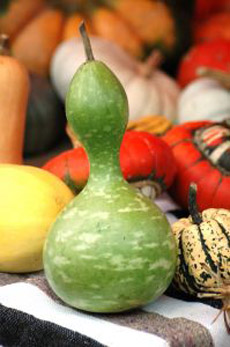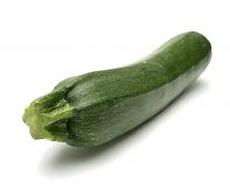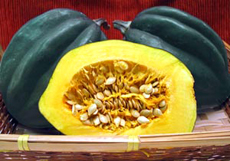
 Looking like a food of the Jetsons on the one hand, the calabash squash is part of quite a few primitive cultures, as you’ll read below. Photo by Nathalie Dulex | SXC. Looking like a food of the Jetsons on the one hand, the calabash squash is part of quite a few primitive cultures, as you’ll read below. Photo by Nathalie Dulex | SXC.
|
MELISSA HOM is an editorial intern at THE NIBBLE.
|
|
June 2006
Updated July 2008 |
 |
Product Reviews / Main Nibbles / Vegetables
Squash Glossary
Summer, Winter And Year-Round Delights
Page 1: Overview & Buying Squash
CAPSULE REPORT: This is the introduction to an eight-page glossary featuring almost 40 different types of squash available in the U.S. Click on the black links below to visit the other pages. See our more than 50 other food glossaries, each featuring a different favorite food.
Overview
Amid the melting pot and hodgepodge of cuisines in the U.S., sometimes you have to wonder, “What is American food?” While Rice Krispies treats and the peanut butter and jelly sandwich are uniquely American recipes, squash is something natively grown in the Americas.
The word “squash” is derived from “askutasquash,” which literally means “a green thing eaten raw” in the language of the Nahahiganseck Sovereign Nation, the native Americans who controlled the area surrounding Narragansett Bay in present-day Rhode Island, portions of Connecticut and eastern Massachusetts. The squash is versatile. While some require cooking, others, like zucchini, can be prepared in every conceivable way: raw, sautéed, grilled, steamed, boiled, broiled, baked, fried, microwaved or freeze-dried. Easily puréed for soups, cakes, pies and quick breads, it also can be spiced and added to rice pilafs, cubed and grilled on skewers, added to stews and made into famous dishes like ratatouille and pumpkin pie. Served alone or as an side dish, the diverse flavors of squash lend itself to any occasion.
Before we go further, let us spring the surprise that although we’ve put this article in our Vegetables Section, squash and gourds are actually fruits! Because they aren’t sweet, they are typically used as vegetables. But by botanical definition, fruits have their seeds on the inside. Squash are fruit, like tomatoes.
Squash can be a caloric bargain with a nutritional bonus.
- Depending on the variety, a half a cup of squash ranges from 50 to 125 calories.
- In one 4-ounce serving, squash provides 20% or more of your recommended daily value of magnesium, potassium, and vitamins A, C and E (vitamin E is found in the seeds).
- Squash is also a good source (10% or more of your RDV) of calcium.
- High in nutrients and flavor, squash is also remarkably high in antioxidants and beta-carotene.
Buying and Storing Squash
The terms “summer” and “winter” squash only loosely refer to when the squash is harvested—most are available year-round. The terms more accurately group the squash by durability.
Summer Squash
Summer squash are thin-skinned and bruise easily (think zucchini), so look for firm, blemish-free ones with taut skin. Typically, the smaller ones are sweeter and more tender. Summer squash are moister—they contain more water—than winter squash. Summer squash are good for about a week in the refrigerator before they begin to soften and wrinkle. |

Summer squash, like zucchini, are thin-
skinned and begin to soften in a week or so.
Photo by Jean Scheijen | SXC. |
Winter Squash
Winter squash, on the other hand, have hard, thick rinds (think acorn squash). They are so hardy that you may find yourself needing a hammer to tap the knife’s handle when trying to cut one in half. This thick skin puts longevity on their side: You can keep winter squash fresh in cool, dark places for one to three months. Winter squash are drier—they contain less moisture—than summer squash. |

Winter squash, like acorn squash, have very thick skins that make them more durable. Photo courtesy of Melissas.com. |
Squash Tips
- Avoid storing squash near apples, avocados or passionfruit, all of which are are natural ripening agents that release ethylene gas. While they are great to throw into a paper bag to aid the ripening process of other fruits like pears, bananas and tomatoes (and to quicken plant flowering), they only discolor and decay zucchini and other dark green squash.
- When storing winter squash with woody stems, such as acorn, buttercup, butternut, turban squash and pumpkins, leave a 4-inch (or longer) stem on the fruit. Fleshy or softer stems, such as those found on banana and hubbard squash, can be cut to one 1 to 2 inches. This helps to retain moisture.
Continue To Part II: Cooking With Squash
Go To Article Index Above
Lifestyle Direct, Inc. All rights reserved. Images are the copyright of their respective owners.

|



